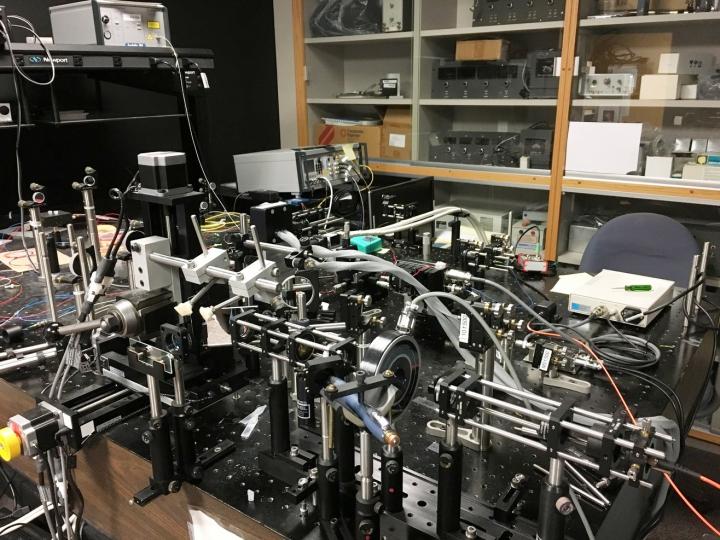New instrument paves the way to earlier detection and treatment of diseases that cause blindness

Credit: Mehdi Azimipour, UC Davis Eye Center.
WASHINGTON — Researchers have developed a new instrument that has, for the first time, measured tiny light-evoked deformations in individual rods and cones in a living human eye. The new approach could one day improve detection of retinal diseases such as age-related macular degeneration, a leading cause of blindness in people over 55 worldwide.
“Our instrument offers a unique way to study retinal disease at the cellular level,” said research team leader Ravi Jonnal from the University of California Davis (UC Davis) Eye Center. “Because existing methods for measuring dysfunction are much less sensitive, it offers a potential new way to detect disease.”
In The Optical Society (OSA) journal Optics Letters, Jonnal and colleagues describe their new instrument, which is based on optical coherence tomography (OCT). Using the new approach, they were able to measure how individual rods and cones respond to light, and could detect deformations that were significantly smaller than the wavelength of the imaging light source.
The work is part of an emerging international field of research that aims to develop methods to fully capture the function of the retinal neural circuit of living people.
Combining imaging methods
Vision begins when rod and cone photoreceptors in the eye’s retina detect light and initiate signals through a process called phototransduction. Retinal diseases such as age-related macular degeneration and retinitis pigmentosa cause vision loss by interfering with the function of rods and cones.
Because rods are thought to be more sensitive to the impacts of these diseases, changes in their function could provide an early indicator of disease or its progression. However, the small size of rods makes it difficult to image them, much less measure how well they are functioning.
In the new work, the researchers developed a unique high-speed OCT system capable of detecting slight swelling in the outer segments of the photoreceptors that occurs as a side effect of phototransduction. The system accomplishes this by capturing specialized OCT images simultaneously with scanning light ophthalmoscope images, enabling it to pinpoint the location and type of photoreceptors captured in a series of hundreds of 3D OCT images.
“Although imaging the swelling of rods and cones can reveal the dynamics of their response to light, until recently, it was not known if these changes could be measured in vivo in the human eye,” said Mehdi Azimipour, first author of the paper. “This is because the size of the photoreceptors and the scale of the light-evoked deformations were well below the resolutions provided by retinal imaging systems.”
Imaging high-speed dynamics
Recently, full-field OCT has been used to visualize the light-evoked deformation of larger peripheral cones. The OCT system developed by the researchers from UC Davis offers better confocality, which improves image quality by rejecting more scattered light and suppressing associated noise. Because the light-evoked deformation of photoreceptors can be very fast, the new system incorporates a high-speed Fourier-domain mode-locked laser that enables fast imaging and can scan 16 times faster than commercially available lasers used for swept source OCT.
To capture the highest resolution images possible, the researchers incorporated adaptive optics technology that measure the eye’s aberrations and corrects them in real time. Even with adaptive optics, rod photoreceptors are too small to be imaged due to the system’s 1-micron-wavelength light source. To overcome this problem, the researchers added a scanning light ophthalmoscope imaging channel that uses a wavelength that is less than 1 micron to increase the imaging resolution. This allowed differentiation of rods and cones in co-registered OCT images.
The researchers used their new instrument to measure the deformations of rods and cones in response to light of varying intensity in living human eyes. The responses of the cells increased as the light intensity increased until saturation occurred, consistent with phototransduction.
Because the new instrument produces large quantities of data (3.2GB/s) over even a small field of view, software needs to be developed to allow scanning of larger areas of retina and automatic data processing. This would make the system more practical for clinical use.
The researchers are now planning to use the instrument to measure photoreceptor light responses of patients with retinal diseases to see if new insights can be gained. “We hope to be involved in using the system to test novel therapies for blinding diseases, to speed up the process of bringing those therapeutics to the clinic,” said Azimipour.
###
Paper: M. Azimipour, D. Valente, K. V. Vienola, J. S. Werner, R. J. Zawadzki, R. S. Jonnal,” Optoretinogram: optical measurement of human cone and rod photoreceptor responses to light,” Opt. Lett., 45,17,4658-4661(2020).
DOI: https:/
About Optics Letters
Optics Letters offers rapid dissemination of new results in all areas of optical science with short, original, peer-reviewed communications. Optics Letters accepts papers that are noteworthy to a substantial part of the optics community. Published by The Optical Society and led by Editor-in-Chief Miguel Alonso, Institut Fresnel, École Centrale de Marseille and Aix-Marseille Université, France, University of Rochester, USA. Optics Letters is available online at OSA Publishing.
About The Optical Society
Founded in 1916, The Optical Society (OSA) is the leading professional organization for scientists, engineers, students and business leaders who fuel discoveries, shape real-life applications and accelerate achievements in the science of light. Through world-renowned publications, meetings and membership initiatives, OSA provides quality research, inspired interactions and dedicated resources for its extensive global network of optics and photonics experts. For more information, visit osa.org.
Media Contact:
Media Contact
James Merrick
[email protected]
Original Source
https:/
Related Journal Article
http://dx.




